Meet December's Featured Designer: Renee Stramel
- Stacie Dale
- Dec 1, 2022
- 8 min read

Tell us about yourself and how you got in to surface design?
I grew up outside of Washington D.C. in Alexandria, VA. I started at Virginia Commonwealth University in Richmond, Va in 1986 and dropped out to go to camera repair school in Washington State. I got my Associates Degree in Photographic Technology in 1992 and I actually repaired cameras until around 2003. When it became apparent that I was becoming obsolete, I knew I didn’t want to adapt to the changing industry and I wanted to do something more creative. I had been taking landscape design classes and that had reawakened my creative side.
A friend of mine spotted an ad for a watercolor artist at a local company that sold hand colored art prints, so I applied. That company had just changed hands and would grow to become World Art Group, an art publishing company here in Richmond. The company grew and changed and I grew with it. I founded the Embellishment Department in the wake of the great recession in 2008. I led a team of 6 other artists creating ‘multi originals’ and embellishing art prints until my exit in 2020. It was a sudden, heart wrenching decision, but the company had been bought out twice in a short time with the last company being a hedge fund. That never ends well! I felt that my team and I were being mislead, as they were promising to keep all our jobs. (Production ended in 2021) We had been expanding into the luxury market, but they didn’t want a product that was hand made. Everything needed a printed barcode. Very frustrating.
When the pandemic hit, the pressure just became too much. I literally ran out of the building one day in September 2020 and I never looked back. The saving grace was that I had spent years licensing work back to the company and still collect royalties to this day. It took me a few months to recover and get enough confidence to reach out to a former competitor whose work I had admired, Grand Image Ltd. I signed with them a year to the day I left WAG. I flew out to their Seattle offices and consulted their production team looking to expand their embellishment techniques and improve efficiencies. It was the life line I needed. In the meantime I had been learning Procreate, sharpening Photoshop skills and trying to learn Illustrator (still trying!) and paying the bills by helping my husband with special FX on a series of heavy metal videos. I joined the Textile Design Lab which was another godsend at the time and opened Spoonflower, Red Bubble and Society 6 shops to upload designs and artwork. I soon found out work that was only on Red Bubble and Society 6 was being ripped off and sold on Amazon. So - those two shops got shuttered. I had put in so much work! A good learning experience for sure, but I decided to hunker down and heavily create work for G.I. I also kept entering Minted Challenges and finally won two ‘editor's pick’ this year. So now, a year after signing with G.I., I’m finally seeing results of my hard work from last year. It has taken that long for things to move through the system.
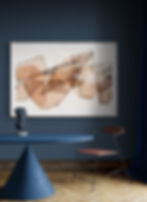
Who or what influences your work the most?
A big one overall influence is Italian design and cinema from the 1960’s and 70’s, especially the thriller/giallo and horror genre’s. Sounds funny, right? So much of the interior design you see right now such as the resurgence of Maximalism, Hollywood Regency, Art Deco, Art Moderne and the superb blending of all of the above can be found in those films and Italian interior design from that period. It’s big, it’s bold, and it’s dramatic.
In terms of artists, a few are David Hockney, The Quilts of Gee’s Bend, Helen Frankenthaler, Ellsworth Kelly, Warhol, Matisse and Folk/Outsider art. Contemporaries such as Wayne White and his son Woodrow White. Marcello Velho’s work is so playful and Jennifer Orkin Lewis and Gayle Kabaker have really opened me up to try and do more illustrative work (along with Woodrow) which fuels my curiosity. The zoom painting classes they hold are fantastic and are donation based. Just listening to them talk about their different approaches to color palettes is invaluable. Lourdes Sanchez, Kate Roebuck, Eskayel’s rug and wall paper designs. I was lucky enough to be longtime friends with artist Wes Freed who passed away recently. (He did artwork for the band The Drive-By Truckers) His life and work has definitely influenced my life and he collaborated with my husband on many film projects. I think the thread between all of them is a commitment to living a life as an artist and a compulsion to create, no matter the media. There are so many artists I could name. I am a lurker on Instagram and have been a longtime pinner on Pinterest to start, but I’m sure I’ll be adding artists to this list in my head while kicking myself I didn’t mention them for a long time coming.

What mediums do you use?
I use watercolor, gouache, acryla gouache, acrylics, procreate, photoshop, cyanotype, collage and I recently just bought supplies to try cold wax oil painting. I love playing with plain old light, shadow and focus when it comes to photography.

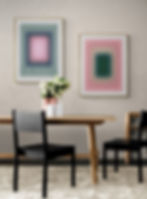
Your work has been licensed extensively in wall art. Tell us about your experience in that sector of surface design?
In the beginning as a production artist, I waited a few years before I really started submitting work consistently. I had to fight just to get it looked at. I wasn’t a designer and there was a real pecking order when it came down to getting work accepted. I was an art school drop out and my work wasn’t florals or landscapes either. Abstracts hadn’t taken over the market yet, like they have today. But, I didn’t give up. I just kept submitting and keeping track of trends and what was selling. Finally after another umpteenth rejection I just told the art director that I wasn’t going to give up. That she could keep rejecting me, but I would not stop bringing her new work. She looked at me dumbfounded. She started to slowly accept work after that. I think I wore her down! Finally, after getting picked by Crate + Barrel and Ethan Allen among others, I was validated. It really goes to show that persistence does pay off and that the answer is always “no” if you don’t ask.


Has wall art been easier to to license than say stationery or illustration?
Yes, for me it has. My work is almost exclusively wall decor right now only because that was my entrance into the business. I have been creating patterns and uploading work to Spoonflower and the Patterfield App but I still feel like such a novice when it comes to creating repeat patterns so I have not been aggressive in contacting companies. My confidence has been building however, and I am looking forward to strategizing more when it comes to complete collections next year; both in wall decor and surface pattern design. I feel like I have just been so scatter shot the last two years in my approach and part of that was just plain ‘overwhelm’ from horrible, horrible freedom, lol. I’m finally hitting a stride and not being so reactionary to every design challenge, zoom call and creative prompt. I was really discombobulated when I left my job and have struggled with Imposter Syndrome and lack of confidence in general. I have noticed a shift in me just in the last half of this year and that new self assuredness has let me slow down, take my time, be more intentional in my actions and not feel so overwhelmed. My goal is quality work over quantity now. I have relationships with local art consultants that have parlayed into some commissions and made me more aware of creating sellable originals and working bigger than the size of my scanner.
Wall Decor is a much smaller industry and everyone knows each other more or less, so I have been more successful there. With the Minted wins, I now have the opportunity to launch my own stationery and fabric designs and I would love to have coordinating work in those categories. In the larger home decor market I hope to one day have designs on wallpaper, rugs, pillows as well as the art on the wall.
I think stepping back now and just observing this new-to-me larger scale industry of surface design will pay off in thoughtful, well-rounded collections in the future. Or so I keep telling myself, lol!
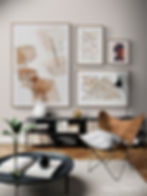
What draws you to create abstract work?
Honestly, I just love abstract work. It’s a short hand of sorts to the viewer and has the power to really make an impact. I want to create work that conveys the joy I had making it and because of that joy, it comes easier to me. I love just playing around with materials, colors and techniques.

Is abstract easier to sell rather than realism in wall art?
Yes, I think so. People buy art to be transported and abstracts are at their core, aspirational. I think there will always be a market for more realistic work for the sheer awe of the talent it takes, but abstracts are a versatile way to express a statement about who you are or who you want to be, whether it’s your own home or in a corporate setting. In 2020, abstracts were 40% of the mass market followed by landscapes, and florals. Figurative was just really getting going and now has it’s own share, but I don’t think abstracts are going away anytime soon.
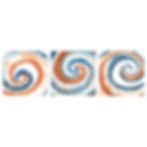
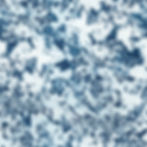
What is your advice to someone trying to break into the market?
Remember that it’s a numbers game and a really long one. It does not matter how much work you create, you will only sell one third of it successfully. It sounds depressing, but it really isn’t. Embrace the freedom in that. It’s like batting .300 in baseball. You are striking out 70% of the time, and that’s OK. You get better. WAG released 150-200 images a week, GI much less, but ratio was the same! Only 30% sold well despite their best efforts and different approaches. So, don’t get too caught up in perfectionism. The good news is that your work will have legs and I have had work that I licensed and forgotten about, suddenly take off years later for some unknown reason. So, pay attention to new color ways and trends, but don’t forget the old stand-by’s. They are perennial because people keep coming back to them. Home decor companies don’t change gears quickly and you can have colors that last for years. Versions of the color teal are one example. (a Benjamin Moore top 10 color for 2023) That color has been around for over 5 years and gray isn’t going anywhere anytime soon. Most wall decor companies are looking for pairs or sets. Sometimes they will take a single work, but that is the exception, not the rule. So I would get used to working that way. One thing that helps me sometimes is working in odd numbers. If I want a pair, I might create 3 pieces and then use the best two, especially if I’m doing collage or experimenting in mixed media. Even if the third one is never fully realized, it seems to help me make choices.

What’s next for you? Are there any companies or designers you’d like to work with?
I’m just starting the planning stages for 2023, and my word for next year is ‘strategy’. What am I doing, why am I doing it and how will success be measured? I will start with one collection of art and patterns and map it out, including the marketing plan. I’ve never done anything cohesive like that before and I need to just buckle down and do it. The marketing will also include reaching out to companies that I have never approached before, but I think having that solid foundation from the start will make me more confident in talking about my work to others. It’s a skill I’ve always struggled with and I want to overcome it.
Kelly Wearstler, Marimekko, Diane von Furstenberg, Camilla Frances, and Ikea would be dream clients. URBN would be another great one, but I also would love to find a smaller company and grow with them. To have a signature style that people would come back to over and over again is certainly my dream overall.









